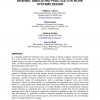Free Online Productivity Tools
i2Speak
i2Symbol
i2OCR
iTex2Img
iWeb2Print
iWeb2Shot
i2Type
iPdf2Split
iPdf2Merge
i2Bopomofo
i2Arabic
i2Style
i2Image
i2PDF
iLatex2Rtf
Sci2ools
IJMMS
1998
1998
Brahms: simulating practice for work systems design
A continuing problem in business today is the design of human-computer systems that respect how work actually gets done. The overarching context of work consists of activities, which people conceive as ways of organizing their daily life and especially their interactions with each other. Activities include reading mail, going to workshops, meeting with colleagues over lunch, answering phone calls, and so on. Brahms is a multiagent simulation tool for modeling the activities of groups in different locations and the physical environment consisting of objects and documents, including especially computer systems. A Brahms model of work practice reveals circumstantial, interactional influences on how work actually gets done, especially how people involve each other in their work. In particular, a model of practice reveals how people accomplish a collaboration through multiple and alternative means of communication, such as meetings, computer tools, and written documents. Choices of what an...
| Added | 22 Dec 2010 |
| Updated | 22 Dec 2010 |
| Type | Journal |
| Year | 1998 |
| Where | IJMMS |
| Authors | William J. Clancey, Patricia Sachs, Maarten Sierhuis, Ron van Hoof |
Comments (0)

